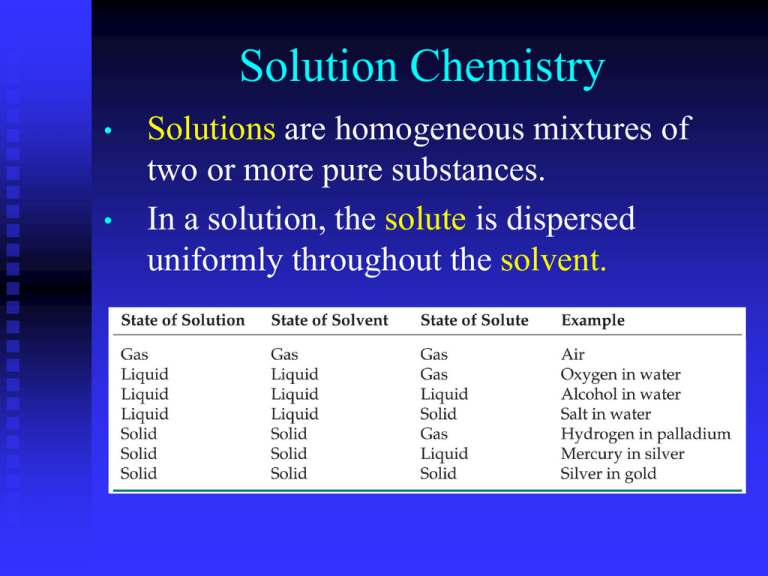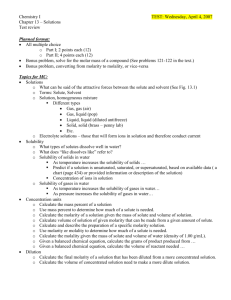Solutions and Solubility
advertisement

Solution Chemistry • • Solutions are homogeneous mixtures of two or more pure substances. In a solution, the solute is dispersed uniformly throughout the solvent. Suspensions • If the particles in a solvent are so large that they settle out unless the mixture is constantly stirred or agitated, the mixture is called a suspension. → Colloids • • Means “glue” in Greek A colloid is a mixture that contains solid particles that are small enough to remain suspended due to the motion of molecules • Examples: Paint - solid dispersed in liquid Milk – liquid dispersed in liquid Shaving cream – gas dispersed in liquid Smoke – solid dispersed in gas • Many colloids look similar to solutions because their particles cannot be seen. • The Tyndall effect can be used to distinguish between a solution and a colloid. • The Tyndall effect occurs when light is scattered by colloidal particles dispersed in a medium. • example: a headlight beam is visible from the side on a foggy night Factors Affecting the Rate of Dissolution 1. 2. 3. • • Surface area of the solute is increased Stirring or shaking Higher temperatures Remember, dissolution is a physical change—you can get back the original solute by evaporating the solvent. If you can’t, the substance didn’t dissolve, it reacted. Types of Solutions • Saturated solution: contains the maximum amount of dissolved solute (undissolved solid remains in the flask) • Unsaturated solution contains less than the maximum amount of solute for a given temperature (no solid remains in flask) • Supersaturated solution: solvent holds more solute than is normally possible at that temperature. Supersaturated solutions These solutions are unstable. Crystallization can often be stimulated by adding a “seed crystal” or scratching the side of the flask. Solubility • Solubility: the amount of substance required to form a saturated solution with a specific amount of solvent at a given temperature example: The solubility of sugar is 204 g per 100 g of water at 20°C • Scientists often use “Like dissolves like” as a rough but useful rule for predicting whether one substance will dissolve in another. • Polar substances tend to dissolve in polar solvents. • Nonpolar substances tend to dissolve in nonpolar solvents. Liquid Solutes and Solvents • • • Oil and water do not mix because oil is nonpolar whereas water is polar. Liquids that are not soluble in each other are immiscible. Liquids that dissolve freely in one another in any proportion are miscible. Effects of pressure on solubility • The solubility of liquids and solids does not change with pressure. • The solubility of a gas in a liquid is directly proportional to its pressure. (Increasing pressure above a solution forces more gas to dissolve.) Known as Henry’s Law The rapid escape of a gas from a liquid in which it is dissolved is known as effervescence. Effects of temperature on solubility • Increasing the temperature usually increases solubility of solids in liquids Effects of temperature on solubility • However the opposite is true for gases. Increasing the temperature usually decreases gas solubility • Carbonated soft drinks are more “bubbly” if stored in the refrigerator. • Warm lakes have less O2 dissolved in them than cool lakes. Concentration The concentration of a solution is a measure of the amount of solute in a given amount of solvent or solution. The opposite of concentrated is dilute. Molarity (M) • Molarity is the number of moles of solute in one liter of solution • The symbol for molarity is M. • To calculate molarity, you must know the amount of solute in moles and the volume of solution in liters. amount of solute (mol) molarity (M) volume of solution (L) Sample Problem A You have 3.50 L of solution that contains 90.0 g of sodium chloride, NaCl. What is the molarity of that solution? Given: solute mass = 90.0 g NaCl solution volume = 3.50 L Unknown: molarity of NaCl solution Solution: 1 mol NaCl 90.0 g NaCl 1.54 mol NaCl 58.44 g NaCl 1.54 mol NaCl 0.440 M NaCl 3.50 L of solution Sample Problem B You have 0.8 L of a 0.5 M HCl solution. How many moles of HCl does this solution contain? Given: volume of solution = 0.8 L concentration of solution = 0.5 M HCl Unknown: moles of HCl in a given volume Solution: 0.5 mol HCl 0.8 L of solution 0.4 mol HCl 1.0 L of solution Molality (m) • • Molality is the concentration of a solution expressed in moles of solute per kilogram of solvent. The symbol for molality is m. molality (m) amount of solute (mol) mass of solvent (kg) • Molality is used when studying properties of solutions related to vapor pressure and temperature changes, because molality does not change with temperature.







